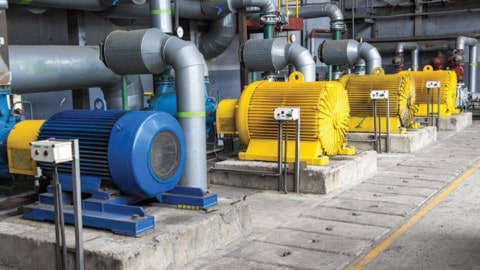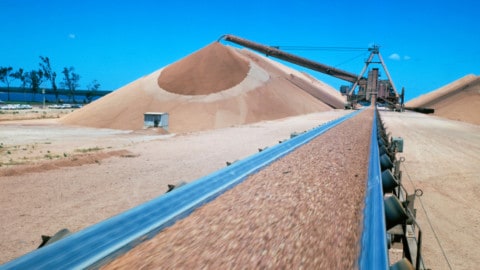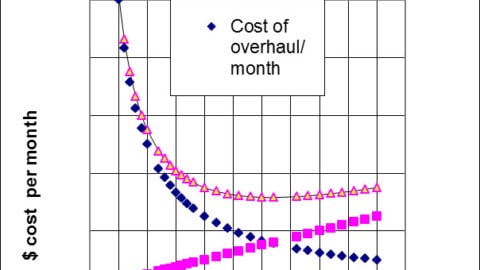The PIA’s Australian Pump Technical Handbook is a cornerstone text for the Australian pump industry and, in our opinion, a must have for anyone who deals with pumps on a regular basis. In this ongoing series, we feature abridged chapters from the classic book to showcase the various areas covered and to reacquaint readers with the technical aspects of pumps. In this issue, we continue our detailed look at selecting and applying different types of positive displacement pumps.

Flexible vane pumps are commonly used in the pharmaceutical industry.
Metering pumps
While various types of pumps can be used for dosing and metering purposes, special designs are available for applications requiring consistently accurate volumetric metering. These are reciprocating positive displacement pumps and are known as metering pumps. Metering pump output must be able to be varied within its operating range and the results of this adjustment must be repeatable.
Various different metering pump designs are available to handle a wide range of flow rates, pressures and liquids. These pumps include diaphragm, plunger and plunger-diaphragm types, with further variations of design within each basic type for specific applications.
All metering pumps consist of the following components:
- Liquid end
- Drive mechanism
- Adjustment mechanism
- Drive motor
- The major types of metering pumps include:
- Mechanically actuated diaphragm/plunger
- Hydraulically actuated diaphragm
- Electromagnetic (solenoid) diaphragm
- Electronic diaphragm
Generally, the operation of the various metering pump types is similar to that of the standard piston, plunger and diaphragm pumps that the metering versions were based on. The main operational differences relate to the various methods of capacity control, and the need to minimise the effects of pressure pulsations in order to maintain metering accuracy.
Mechanically actuated diaphragm/plunger
In this type of metering pump a reciprocating connecting rod or cam, located within an oil bath lubricated gearbox, displaces a diaphragm or plunger over a given length within the pumping chamber. Via the hydraulic opening and closing of the internal inlet and outlet check valve, this accurately displaces a continuous injection of the liquid to the process, the amount of which can be adjusted either manually or automatically. Typically, these pumps are driven by AC motors.
Plunger designs have a static seal on the plunger, which is subject to leakage and must not run dry. These designs are suitable for higher pressures.
On the other hand, diaphragm designs are sealless, which can be very important when pumping hazardous or expensive fluids. These pumps are capable of running dry.
Hydraulically actuated diaphragm
This type of metering pump combines the benefits of the sealless construction of the mechanical diaphragm pump with the higher pressure capabilities of the plunger metering pump design.
The diaphragm is hydraulically coupled to the plunger so that the plunger displaces oil within a cavity, which in turn displaces the diaphragm. This design requires a positive flooded suction and normally features an inbuilt pressure release valve for pump protection.
Electromagnetic (solenoid) diaphragm
In this metering pump design the diaphragm is displaced by energising/de-energising the restricted movement of a plunger within a solenoid coil.
The plunger is mechanically linked to a diaphragm that displaces the liquid volume on a noncontinuous (on/off) principle. Capacity adjustment is achieved manually or by a range of direct automatic input signals.
Electronic diaphragm
Based on the same principles as the mechanically actuated metering pump, this design incorporates both manual and electronic control features similar to the electromagnetic metering pump by varying the “off period” of time of a single phase AC motor.
Selection of metering pumps
Different types of metering pumps demand different approaches for selection. Simple low-cost off-the-shelf solenoid pumps can generally be selected from tables in catalogues. However, more demanding applications are best referred to the manufacturer or distributor.
Characteristics of metering pumps
After accuracy, one of the most important characteristics of metering pumps is capacity control.
A metering pump’s capacity adjustment system should fulfil the following requirements:
- Ease of operation
- Adjustable while pump is in operation
- Accurate repeatable settings
- Maintain consistent output over a long period of time
- There are various types of capacity control, including manual, electrical and pneumatic.
It is also important to note that no matter how well designed and manufactured the pump is, it may not give satisfactory service if it is not installed correctly.
Careful consideration should be given to:
- The pump location
- Piping and accessories
- Priming
- Back pressure, relief and isolating valves
- Suction strainers, pressure gauges, piping layout
Common applications for metering pumps
Metering pumps are used to pump a wide range of chemicals in a diverse range of industries. The type used depends on many factors including duty cycle, required metering accuracy, and the nature of the liquids handled.
Common applications include, but are not limited to:
- Light duty
- Fertilisers and nutrients in farming and commercial nurseries
- Medium duty
- Food and additives in food manufacturing, dairies and wineries
- Dyes in the textile industry
- Chemicals in municipal water and sewage treatment
- Heavy duty
- Petrochemical industry
- Pulp and paper manufacturing
- Mining and mineral treatment
Vane pumps
Vane pumps are available in a number of vane configurations including sliding vane, flexible vane, swinging vane, rolling vane and external vane. Each type of vane pump offers unique advantages.
In one of the most common sliding vane designs, a rotor with radial slots is positioned off-centre in a housing bore. Vanes that fit closely in rotor slots slide in and out as the rotor turns. Vane action is aided by centrifugal force, hydraulic pressure, or pushrods. Pumping action is caused by the expanding and contracting volumes contained by the rotor, vanes and housing.
Vanes are the main sealing element between the suction and discharge ports and are usually made of a non-metallic composite material. Rotor brushings run in the pumped liquid or rotors use roller bearings isolated by seals.
Despite the different configurations, most vane pumps operate via the same general principle:
- A slotted rotor is eccentrically supported in an eccentric cam. The rotor is located close to the wall of the cam so a crescent-shaped cavity is formed. The rotor is sealed into the cam by two side plates. Vanes or blades fit within the slots of the impeller. As the rotor rotates and fluid enters the pump, centrifugal force, hydraulic pressure, and/or pushrods push the vanes to the walls of the housing. The tight seal among the vanes, rotor, cam, and side plate is key to the good suction characteristics common to the vane pumping principle.
- As the rotation continues, the cavity volume increases, allowing fluid into the pumping chamber through holes in the cam.
- As the rotor continues around, the vanes sweep the fluid to the opposite side of the crescent where it is discharged through the discharge holes of the cam as the cavity volume decreases. Fluid then exits the discharge port.
Characteristics of vane pumps
While vane pumps can handle moderate viscosity fluids, engineered non-metallic vane materials make these pumps well suited to handle low viscosity, non-lubricating liquids such as LP gas, ammonia, solvents, alcohol, fuel oils, gasoline, and refrigerants.
Vane pumps have no internal metal-to-metal contact and self compensate for wear, enabling them to maintain peak performance on these non-lubricating liquids. Efficiency drops quickly as viscosity increases above 200 centipoise, but they can be used up to about 10,000 centipoise.
Vane pumps are noted for their dry priming, ease of maintenance, and good suction characteristics over the life of the pump. The pumps can usually handle fluid temperatures from -32°C to 260°C and differential pressures to 15 bars (higher for hydraulic vane pumps).
Common applications for vane pumps
Some common applications for vane pumps include:
- Transport tanker services of petroleum products
- Pumping fuels, lubricants and refrigeration coolants in the auto industry
- Bulk transfer of LPG and ammonia
- LPG cylinder filling
- Aerosols and propellants
- Alcohols and solvents
- Refrigeration
Flexible vane pumps
The design of flexible vane pumps is much simpler than the sliding vane design. These pumps use a flexible (usually rubber) impeller instead of a separate rotor and sliding vanes, and a simple eccentric casing with a single inlet and outlet port instead of a double wall casing with holes in the cam.
These pumps are usually only available in small sizes and for low heads. They create a very good vacuum but can only handle very small solids.
A wide range of available casing and rotor materials, as well as many different elastomers for the flexible vane, mean these pumps can be used in a broad range of industries. The pumps are either belt-driven or direct-coupled to motors. Magnetic drives units are also available.
Common applications for flexible vane pumps include:
- Pumping engine cooling water
- Marine bilge pumps
- Food, beverage and pharmaceuticals
- Chemicals and paints
Peristaltic pumps
The term “peristaltic pumps” refers to hose or tube pumps. Although there are specific differences between hoses and tubing, these terms are generally used interchangeably.
Peristaltic pumps are self-priming rotary positive displacement pumps that consist of three major parts: hose or tubing, housing, and rotor.
The hose is located in the tubing bed between the rotor and housing. The rotor has a number of “rollers” or “shoes” attached to the external circumference.
Generally hose pumps have polyamide reinforcing layers, thick walls, and are capable of handling differential pressures to 15 bars. Tube pumps use tubing with thinner walls and can generally handle pressures up to 4 bars.
The stiff, reinforced walls of the hoses used in hose pumps mean greater force is needed to occlude the hose. This means a bigger pump and motor is required for a given flow rate for a hose pump compared to a tube pump. As a result the hose pump requires more power to run.
In these higher pressure designs, the hose and the shoe mechanism operate in a glycerin bath to reduce friction on the hose and dissipate the heat caused by its compression.
When operating a peristaltic pump, liquid is trapped between the shoes or rollers. As the shoes move across the hose, the hose is occluded, pushing the liquid along. The hose behind the shoe or roller recovers its shape, creating a vacuum and drawing more fluid in.
Flow rate is determined by multiplying speed (rpm) by the volume of trapped liquid. The volume moved is consistent, even under a wide range of viscosities or densities. The flow rate is therefore directly proportional to the gearbox speed.
Selection of peristaltic pumps
After selecting a suitable size for the flow pressure and duty condition (continuous or intermittent), speed and power can be read from a performance chart.
However, hose life and materials are critical for the successful application. It is recommended that the final selection is done by the manufacturer or authorised representative.
Characteristics of peristaltic pumps
Essentially, the main wearing part of the pump is the hose. This is both a strength and a weakness. If properly and conservatively selected, the hose, and therefore the pump, will give long operating life between overhauls. But if care is not taken, hose life can be short.
Hose life depends in a range of factors:
- The amount of squeeze applied to the hose affects pumping performance and the hose life. More squeezing decreases the hose life dramatically, while less squeezing decreasing pumping efficiency, especially at high pressures. Therefore, the amount of squeeze becomes an important design parameter.
- Mechanical capability is a function of hose material and the number of times the hose is squeezed. Therefore, pump speed is a significant factor in hose life.
- The hose needs to be elastomeric and maintain the circular cross section after millions of cycles of squeezing in the pump. Different hose materials have different mechanical flex lives. The most common hose material is natural rubber.
- Chemical compatibility. As the pumped fluid only makes contact with the inside of the hose, the only compatibility to worry about in a peristaltic pump is that between the hose materials and the fluid.
- The implications of temperature should also be considered. The normal rated temperature for hose pumps is 40°C. Normal maximum temperature is 80°C, subject to adjustments to either maximum pump speed or maximum discharge pressure.
The key advantage of peristaltic pumps is the sealless design with no moving parts in the pumped fluid. Discharge pulsations are low, self-priming is good, the pump can handle high viscosities, and capacity accuracy is maintained for good process control. The pumps can be run dry. Performance on high concentration, high SG abrasive slurries is good.
Because of the requirement to keep running speed low, the pumps tend to be large and relatively expensive.
Capacities generally range up to 90 m3/h with pressure 16 bars.
Common applications for peristaltic pumps
Common applications for peristaltic pumps include, but are not limited to:
- Mining slurry transfer
- Thickener underflow
- Reagent dosing
- Wastewater containing fibrous materials, fillers, chemical residues
- Sludge transfer
- Filter press feed
- Printing inks
- Laboratory and pharmacy applications such as blood transfer and product dosing
Read part one of ‘Selecting and applying positive displacement pumps’ here.
















